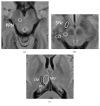Deep Brain Stimulation in Parkinson's Disease: New and Emerging Targets for Refractory Motor and Nonmotor Symptoms
- PMID: 28761773
- PMCID: PMC5518514
- DOI: 10.1155/2017/5124328
Deep Brain Stimulation in Parkinson's Disease: New and Emerging Targets for Refractory Motor and Nonmotor Symptoms
Abstract
Parkinson's disease (PD) is a progressive neurodegenerative condition characterized by bradykinesia, tremor, rigidity, and postural instability (PI), in addition to numerous nonmotor manifestations. Many pharmacological therapies now exist to successfully treat PD motor symptoms; however, as the disease progresses, it often becomes challenging to treat with medications alone. Deep brain stimulation (DBS) has become a crucial player in PD treatment, particularly for patients who have disabling motor complications from medical treatment. Well-established DBS targets include the subthalamic nucleus (STN), the globus pallidus pars interna (GPi), and to a lesser degree the ventral intermediate nucleus (VIM) of the thalamus. Studies of alternative DBS targets for PD are ongoing, the majority of which have shown some clinical benefit; however, more carefully designed and controlled studies are needed. In the present review, we discuss the role of these new and emerging DBS targets in treating refractory axial motor symptoms and other motor and nonmotor symptoms (NMS).
Figures
Similar articles
-
Subthalamic GAD gene transfer in Parkinson disease patients who are candidates for deep brain stimulation.Hum Gene Ther. 2001 Aug 10;12(12):1589-91. Hum Gene Ther. 2001. PMID: 11529246 Clinical Trial.
-
Deep brain stimulation for Parkinson's disease: meta-analysis of results of randomized trials at varying lengths of follow-up.J Neurosurg. 2018 Apr;128(4):1199-1213. doi: 10.3171/2016.11.JNS16715. Epub 2017 Jun 30. J Neurosurg. 2018. PMID: 28665252
-
Deep brain stimulation of globus pallidus interna, subthalamic nucleus, and pedunculopontine nucleus for Parkinson's disease: which target?Parkinsonism Relat Disord. 2012 Jan;18 Suppl 1:S165-7. doi: 10.1016/S1353-8020(11)70051-7. Parkinsonism Relat Disord. 2012. PMID: 22166422 Review.
-
Meta-analysis comparing deep brain stimulation of the globus pallidus and subthalamic nucleus to treat advanced Parkinson disease.J Neurosurg. 2014 Sep;121(3):709-18. doi: 10.3171/2014.4.JNS131711. Epub 2014 Jun 6. J Neurosurg. 2014. PMID: 24905564
-
Congress of Neurological Surgeons Systematic Review and Evidence-Based Guideline on Subthalamic Nucleus and Globus Pallidus Internus Deep Brain Stimulation for the Treatment of Patients With Parkinson's Disease: Executive Summary.Neurosurgery. 2018 Jun 1;82(6):753-756. doi: 10.1093/neuros/nyy037. Neurosurgery. 2018. PMID: 29538685 Free PMC article.
Cited by
-
Brain-focussed ultrasound: what's the "FUS" all about? A review of current and emerging neurological applications.Br J Radiol. 2018 Jul;91(1087):20170481. doi: 10.1259/bjr.20170481. Epub 2018 Mar 6. Br J Radiol. 2018. PMID: 29419328 Free PMC article. Review.
-
Effects of bilateral subthalamic nucleus deep brain stimulation on motor symptoms in Parkinson's disease: a retrospective cohort study.Neural Regen Res. 2021 May;16(5):905-909. doi: 10.4103/1673-5374.297089. Neural Regen Res. 2021. PMID: 33229727 Free PMC article.
-
Coordinate based meta-analysis of motor functional imaging in Parkinson's: disease-specific patterns and modulation by dopamine replacement and deep brain stimulation.Brain Imaging Behav. 2020 Aug;14(4):1263-1280. doi: 10.1007/s11682-019-00061-3. Brain Imaging Behav. 2020. PMID: 30809759 Free PMC article. Review.
-
Methodological Considerations for Neuroimaging in Deep Brain Stimulation of the Subthalamic Nucleus in Parkinson's Disease Patients.J Clin Med. 2020 Sep 27;9(10):3124. doi: 10.3390/jcm9103124. J Clin Med. 2020. PMID: 32992558 Free PMC article.
-
Motor recovery and antidepressant effects of repetitive transcranial magnetic stimulation on Parkinson disease: A PRISMA-compliant meta-analysis.Medicine (Baltimore). 2020 May;99(18):e19642. doi: 10.1097/MD.0000000000019642. Medicine (Baltimore). 2020. PMID: 32358345 Free PMC article.
References
Publication types
LinkOut - more resources
Full Text Sources
Other Literature Sources
Research Materials
Miscellaneous


